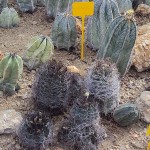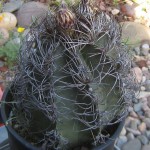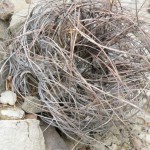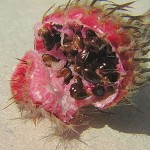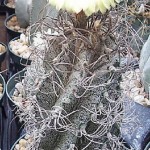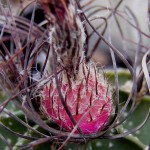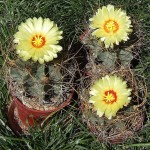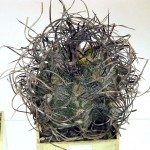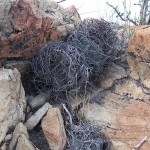Family: Cactaceae
Synonymous: Astrophytum senile
Astrophytum capricorne var. senilis
Echinocatus capricornis
Distribution and habitat: Astrophytum capricorne is a cactus widespread in the Chihuahuan Desert in Northern Mexico, in desert areas where rainfall is much lower - rainfall below 200mm/year (8 inch/year) - than in the habitat of other Astrophytum species. It grows mainly on limestone situations, among rocks and thorny bushes. He appreciates during its first years the protection of Agaves lechuguilla.
This cactus gets its common name, the Goat's Horn Cactus, from the characteristic shape of its long, curled and spines - a grass-mimicry to camouflage the cactus among its surroundings.
Description: Astrophytum capricorne is a solitary globose or columnar cactus with variable shapes ( spines , flakes , growth) developed in order to perfect its mimicry in various habitats. Although young plants are globular, they soon become egg-shaped with age and eventually columnar up to 1.2m (4 feet) tall and 10 to 15cm (4-6 inch) in diameter. It is a strange looking species because of its display of curved spines on the stem which usually has eight prominent ribs that form around the edge from the top of the cactus to the bottom. The spines are 5 to 10 up to 7cm (3 inch) long, grey to brown wired, twisted, curved and flattened. They are rising from areoles arranged in vertical rows along each rib. As plant ages spines get a bit more intense and messier, but relatively sparse, they are stiff, but pliable and fragile. Young specimens will not have the characteristic spines as adult cacti. The epidermis of this cactus is dark green and more or less covered with the typical white woolly flecks characteristic of the genus. New flakes that appear on the apex tend to be brown before taking white colour.
The flower is yellow with a rather beautiful dark red throat. Blooming season is summer, but only mature Astrophytum capricorne - 3 to 4 years old cactus if growing conditions are favorable - will produce flowers. The flowers appear at the apex of the plant, at the base of each new areola. In warm weather, they last only one day or, in best circumstances, they will open again the next day. The flowers ofAstrophytum capricorne open during the hot afternoon with asweet fragrance.
The fruit covered with flattened spines, is 2.5cm (1 inch)in diametre, will turn red when ripe and open at the bottom. The seeds are large enough coloured bumpy red to brown.
Proper care: Because Astrophytum capricorne has fairly sharp prickly spines, use extreme caution when handling and wear gloves.
Overall this cactus is an easy grower and even the worst neglectcactus should be able to manage. It will grow to a slow rate.
Light: Astrophytum capricorne are desert cacti, therefore they loves sun and will grow well if provided with plenty of direct sunshine. To young specimens should be provided with indirect sunlight.
With inadequate light which could result in poor growth and unnatural shape.
Temperature: Astrophytum capricorne thrive in average room temperatures between 16-24C (61-75F) from spring until fall. From late autumn to late winter give them a rest winter at temperatures between 7-10C (45-50F ).
Normal indoor humidity is fine forAstrophytum capricorne cactus. Provide good air ventilation for healthy growth.
Watering:During the active growth period water these plants moderately, but allow the top three-quarters of the mixture to dry out thoroughly between waterings. During the rest period give only enough water to prevent the mixture from drying out.
Feeding: Give to Astrophytum capricorne a diluted cactus fertiliser during spring and until the end of summer, once very four weeks. They thrive in poor soils and need a limited supplies of fertiliser. Do not over use fertiliser as this can affect and damage the roots.
Potting and repotting: Astrophytum capricorne do best in a mixture which is composed of one part coarse sand to two parts of either soil-based mixture.
Repot annually young cacti up to 3 or 4 years old, after that repot them only if necessary. Any cactus up to 5 cm (2 inch) in diameter may be kept in an 8cm (3 inch) pot. It is advisable, however, to remove plants from their pots in early spring. If the roots are tightly packed in the present pot, the plant should be repotted in a larger one. Otherwise, replace the plant in its original pot with fresh potting mixture.
A layer of gravel mix or small pebbles can be laid at the top ( maybe an inch deep) to give them desert look.
Gardening: In general, Astrophytum capricorne should never left outdoors unless it is being kept in a climate very similar to its natural habitat.
Position: Astrophytum capricorne is suited for sunny-brightly exposure, but can tolerate light shade. It has a good heat tolerance and requires good ventilation.
This cactus likes warmth - recommended minimum winter temperature is around 5C (41F) - but cacti kept perfectly dry can easily survive to light frost - it is reported hardy to -7C (19F) for brief periods. Protect it from snow.
Soil: Use alkaline lime based soil with good drainage as this species is rot prone.
Irrigation: Water sparingly from spring to autumn and keep perfectly dry in winter or when night temperatures remain below 10C (50F). In climates that are typically wet in winter, it may be necessary to keep this cactus in a cold frame or an unheated greenhouse. Larger plants are able to adapt to life in the garden with more ease than small seedlings.
These cacti are drought-tolerant.
Fertilization: Feed Astrophytum capricorne once during the growing season with a fertiliser specifically formulated for cactus and succulents (high potash fertilizer with a dilute low nitrogen), including all micro nutrients and trace elements diluted to half the strength recommended on the label. They thrive in poor soils and need a limited supplies of fertiliser to avoid the plants developing excess vegetation, which is easily attacked by fungal diseases.
Propagation: Astrophytum capricorne can be propagated easily from seed as it seldom produces offsets. The seeds can be sown in pots of fine, well-drained sandy soil, any time during the spring when temperatures are warm at about 21-27C (70-81F). Cover the seeds with a fine layer of grit and water from below with a fungicide to prevent damping off. For the 1-2 weeks cover the pots with a sheet of glass/clear perspex to keep the humidity levels high. Remove the glass and replace it with light shade-cloth and mist once or twice a day for the next two weeks after which most seeds should have germinated. At this point, mistings can be reduced to every second and then every third day as the little plants grow. The seedlings should not be disturbed until they are well rooted after which they can be planted separately in small pots.
Sometimes it is grafted to avoid root rot problems as plants grafted on an hardy stock are easy to grow and no special skill is required.
Problems: Nearly all cultivation problems withAstrophytum capricorne occur as a result of overwatering and poor ventilation, especially when weather conditions are dull and cool or very humid.
Red spiders may be effectively rubbed up by misting the plants from above.
Treatment: Use a suitable pesticide to combat these pests.
Mealy bugs occasionally develop aerial into the new leaves and flowers with disfiguring results, but the worst types develop underground on the roots and are invisible except by their effects.
Treatment: A regular, careful inspection is needed. Occasional watering with systemic insecticides based on Imidacloprid will keep the plants free of mealy bugs.
Scales, thrips and aphids are rarely a problem.
Treatment: Use a suitable pesticide to combat these pests.
Rot is only a minor problem if the plants are watered and aired correctly. If they are not, fungicides wold not help all that much.
Treatment: Discard badly affected plants. Prevent rotting by keeping cacti in well ventilated places, using well drained potting mixture and proper pot size and watering correctly.
Note: Astrophytum capricorne has spines or sharp edges; use extreme caution when handling. This cactus could be a hazard for children.
Uses and display:Astrophytum capricorne are grown for their display of curved, long,grass-mimicry spines, making it a strange specimen between cacti collections and a stunning featureas an old giant cactus inxeriscaping or rock gardens.
Young, small specimens ofAstrophytum capricorne are ideally suited to window-sill conditions or balconies or patios.
SUMMARY:
CHARACTERISTICS:
Foliage green
Features flowers
Shape globular
Height: 45cm (18 inch)
PROPER CARE:
Watering in rest period sparingly
Watering in active growth period moderately
Light direct
Temperature in rest period min 7C max 10C (45-50F)
Temperature in active growth period min 16C max 24C (61-75F)
Humidity low
Hardiness zone: 9b-11

